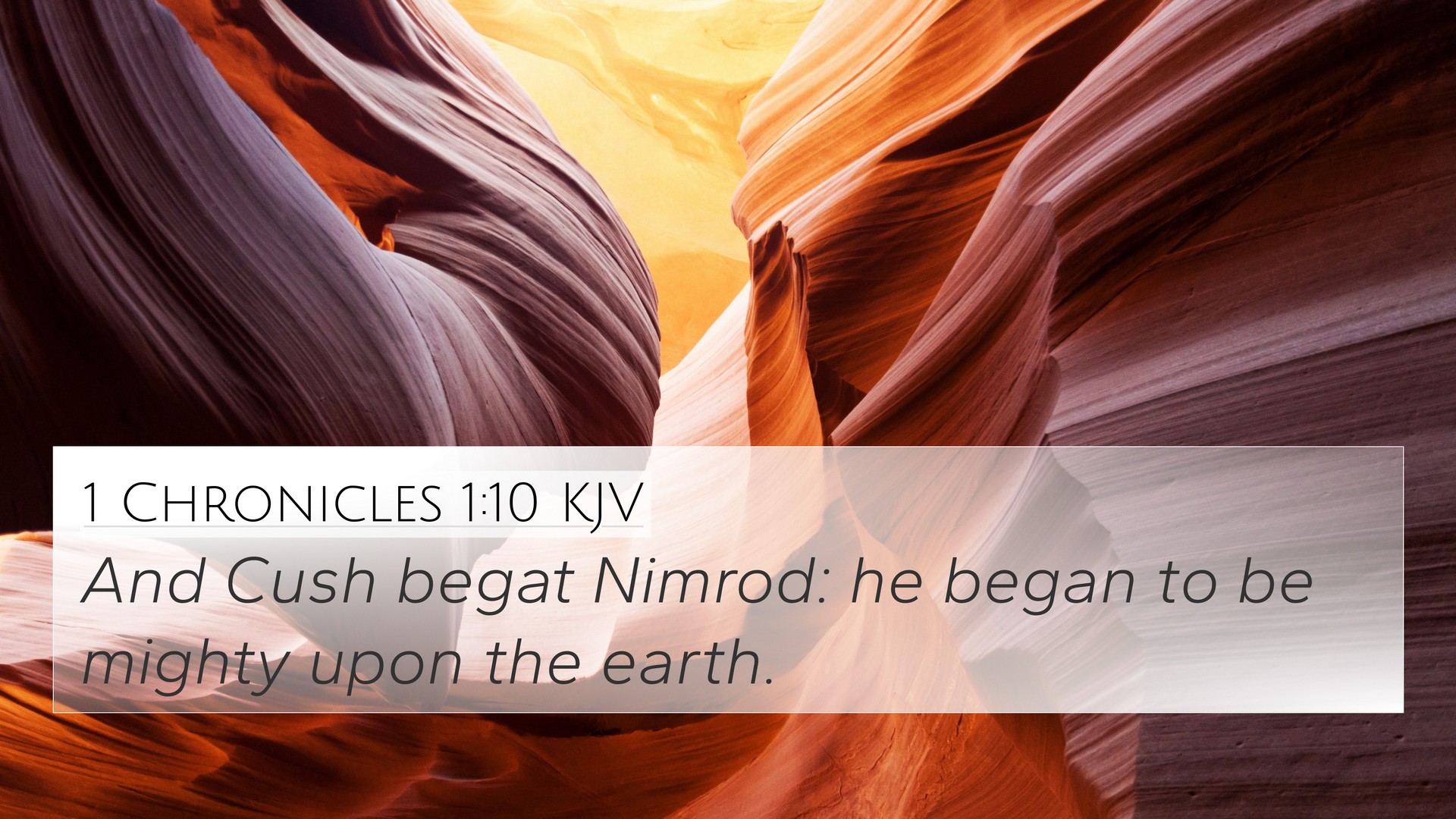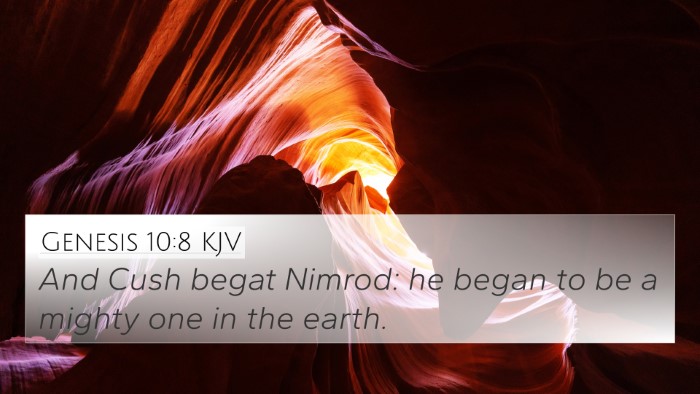Understanding 1 Chronicles 1:10
1 Chronicles 1:10 reads, "Cush begat Nimrod; he began to be a mighty one in the earth." This verse succinctly introduces one of the significant figures in biblical history, Nimrod, who is often associated with rebellion against God and the formation of empires.
Insights from Public Domain Commentaries
Matthew Henry's Commentary:
Henry notes that Nimrod, being a descendant of Cush, signifies a lineage of strength and notable heritage. The description of him as a "mighty one" implies not just physical prowess but also leadership capabilities that led to the establishment of kingdoms. Henry attributes Nimrod’s might to his departure from the Godly path, indicating that his influence was both expansive and detrimental. Nimrod could be viewed as a symbolic representation of human ambition and the desire for power, often opposing divine authority.
Albert Barnes' Notes:
Barnes emphasizes the historical context, highlighting that Nimrod is considered a hunter and a warrior. He infers that Nimrod's might in the earth relates to both his skills in hunting and dominion, possibly indicating his role in the founding of cities such as Babel. This interpretation suggests that Nimrod's endeavors were noteworthy not merely for their scale, but also for their impact on future generations, emphasizing the importance of power dynamics in early civilization as recorded in the biblical canon.
Adam Clarke's Commentary:
Clarke offers insight into the etymology of Nimrod's name, suggesting it could mean "rebel." He elaborates that his might was not just physical; it implies a significant deviation from God’s authority. Clarke further connects Nimrod to the Tower of Babel narrative, asserting that his ambitions reflect mankind’s ongoing conflict with God, particularly in their attempts to reach heaven through rebellion. Thus, Nimrod is portrayed not just historically, but also thematically related to human disobedience.
Cross-Referencing with Other Scriptures
To enhance our understanding of 1 Chronicles 1:10, here are several important Bible verses that cross-reference with this passage:
- Genesis 10:8-10: "And Cush begat Nimrod: he began to be a mighty one in the earth." This passage expands on Nimrod's beginnings and establishes his place in biblical genealogies.
- Genesis 11:1-4: Discussing the Tower of Babel, which Nimrod is traditionally associated with, provides insight into his ambition and desire to unify humanity against divine command.
- Micah 5:6: References to Assyria and Nimrod serve to showcase the interconnections between empires and their leaders, hinting at the legacy left by Nimrod.
- Numbers 24:22: A mention of the Kenites and their fate ties back to Nimrod's line, indicating the extended impact of his actions.
- Deuteronomy 12:29-31: Discusses the moral dangers associated with desiring power and idol worship, reminiscent of Nimrod's legacy.
- Luke 3:36: This genealogy in the New Testament traces back through the lineage of Cush, providing continuity of Nimrod's significance even in the New Covenant.
- Revelation 18:2: The fall of Babylon is linked to Nimrod's legacy, showcasing the eventual divine judgment against the systems he helped establish.
Thematic Connections and Conclusions
From a broader perspective, 1 Chronicles 1:10 and its associated commentaries reflect the continuous biblical theme of human ambition versus divine order. The legacy of Nimrod serves as a cautionary tale throughout Scripture, depicted not merely as a historical figure but as an archetype of rebellion against God. The exploration of his character and lineage invites further comparative analysis between Old and New Testament teachings regarding power, authority, and the consequences of turning away from divine instruction.
In summary, understanding 1 Chronicles 1:10 allows for an in-depth exploration of how biblical texts interconnect and how thematic elements permeate the Scriptures, demonstrating the importance of cross-referencing for a holistic understanding of Biblical narratives.




